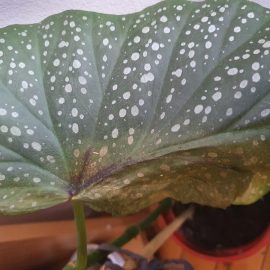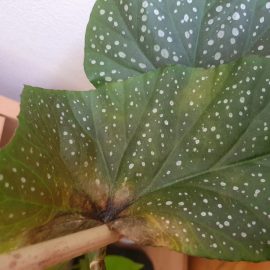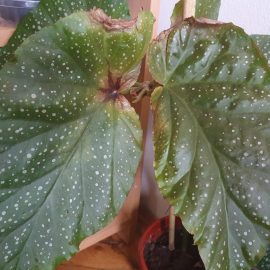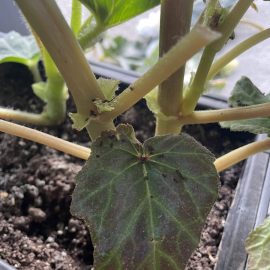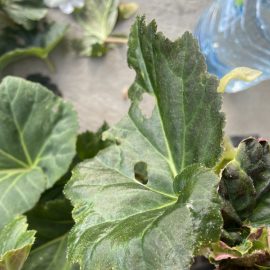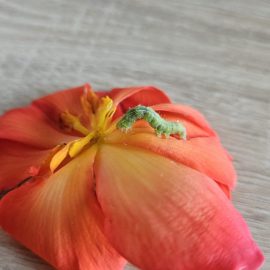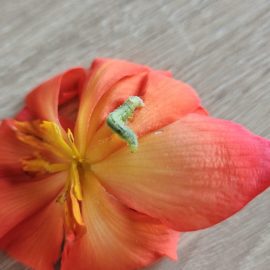Begonia, plant care and growing guide
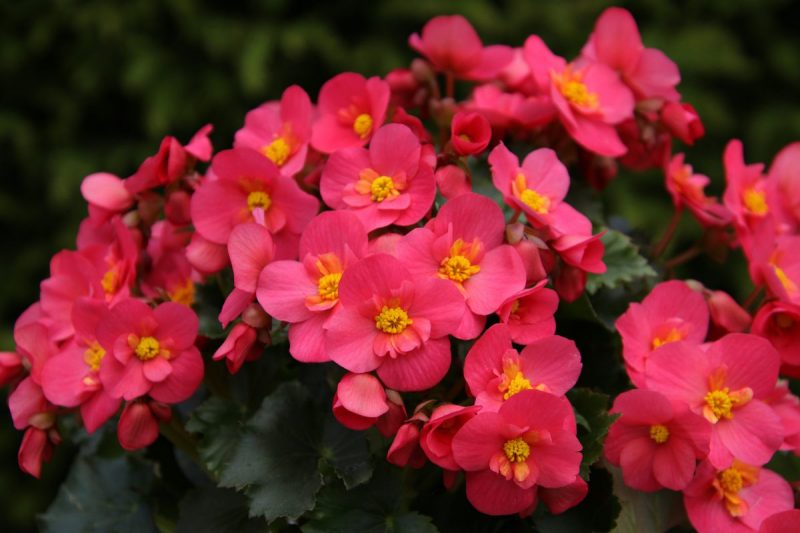
Originally from Central and South America, India, and Indonesia, the Begonia genus includes herbaceous, succulent plants, considered decorative thanks to their flowers and leaves. There are about 400 species of Begonias, used as houseplants and garden plants. Begonia has the aspect of a bush and a height between 20 and 50 cm, depending on the species.
Species and varieties
Begonias are divided into:
Rhizomatous begonias – a decorative species thanks to the variety of leaves, which remain permanently green:
- Begonia coralina – has large, asymmetrical leaves (much longer than wide), dark green with irregular silver spots on their surface. The flowers are large, coral-red, arranged in long clusters, and bloom almost all year round.
- Begonia rex – the leaves are cordiform, asymmetrical, corrugated, with a sharp tip and wavy edge. The leaves color varies from green to red with different spots or mosaics. The flowers are pink or red, small, and unnoticeable.
- Begonia masoniana – the leaves are green with a purple-brown spot on the vein line.
Tuberous begonias – species that produce large and colorful flowers during the summer:
- Begonia x tuberhybrida – has asymmetrical leaves, palmate, ovate, and toothed. The flowers are large, variously colored, luxuriant, and arranged axially 3 at a time.
Wax or fibrous begonias – species that partially lose their leaves in winter:
Begonia semperflorens – it has glossy, oval, fleshy leaves, which are green or reddish. The flowers are simple or double, red, pink, white, or orange.
Begonia metalica – the leaves are thick, colored in copper-green, with a metallic sheen on the upper side and reddish on the lower side. The flowers are small, white or pink.
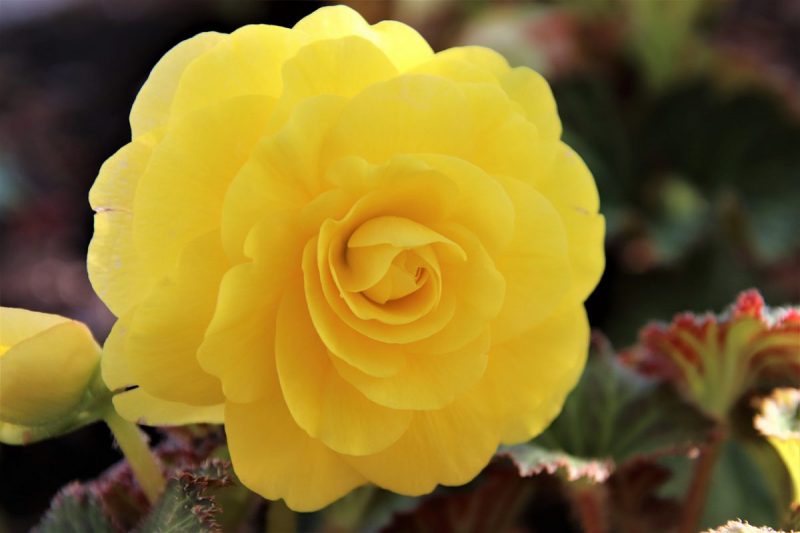
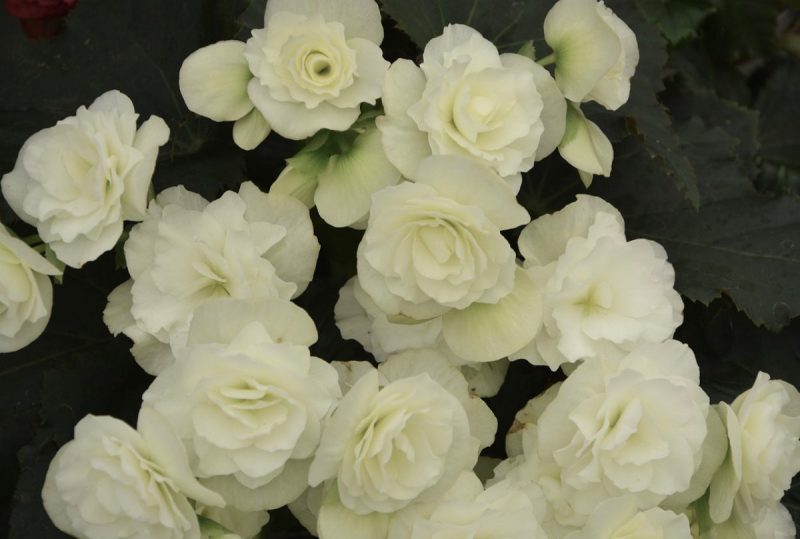
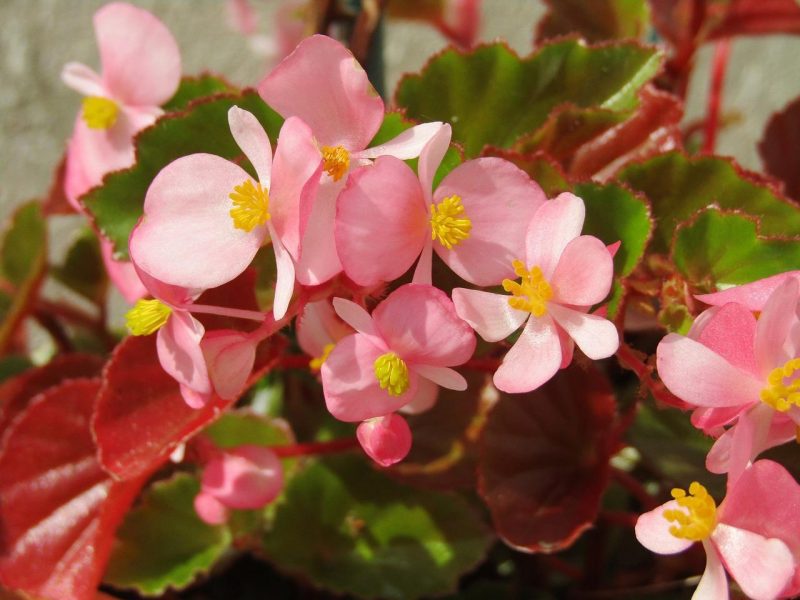
Environmental conditions
Light. Begonias prefer bright places, but away from direct sunlight.
Temperature. They are heat-loving plants, the optimum temperature is 20-25° C. Decorative Begonias with flowers can bloom all year round if they have favorable environmental conditions. However, is recommended a semi-dormant period in winter when the temperature should be maintained at 14-15° C, and the plants should be watered less often and with less water. Tuberous begonias have deep dormancy in winter, so during dormancy, it is recommended to stop watering.
Humidity. Begonia needs high atmospheric humidity and must be protected from drafts. The substrate must be kept slightly moist.
Substrate. It is recommended to be rich in humus, slightly acidic, and to have a good drainage capacity.
Recommended products
-
You can find products on a different store
Change Store -
You can find products on a different store
Change Store -
You can find products on a different store
Change Store -
You can find products on a different store
Change Store -
You can find products on a different store
Change Store -
You can find products on a different store
Change Store -
You can find products on a different store
Change Store -
You can find products on a different store
Change Store -
You can find products on a different store
Change Store -
You can find products on a different store
Change Store -
You can find products on a different store
Change Store -
You can find products on a different store
Change Store -
You can find products on a different store
Change Store -
You can find products on a different store
Change Store -
You can find products on a different store
Change Store -
You can find products on a different store
Change Store -
You can find products on a different store
Change Store -
You can find products on a different store
Change Store -
You can find products on a different store
Change Store -
You can find products on a different store
Change Store -
You can find products on a different store
Change Store -
You can find products on a different store
Change Store -
You can find products on a different store
Change Store -
You can find products on a different store
Change Store
Watering
Watering should be done with moderate amounts of water, without splashing the leaves, as brown spots may appear on them. You should allow the substrate to dry on the surface before watering the plant again.
Atmospheric humidity should be kept high by spraying water in the air around the plant, without spraying the leaves. Another method is to place the plant on a tray with wet gravel. The substrate at the base of the pot shouldn’t be permanently wet, to prevent root rot.
Fertilization
It should be done from spring to autumn, with specific fertilizers.
Recommended products
-
You can find products on a different store
Change Store -
You can find products on a different store
Change Store -
You can find products on a different store
Change Store -
You can find products on a different store
Change Store -
You can find products on a different store
Change Store -
You can find products on a different store
Change Store -
You can find products on a different store
Change Store -
You can find products on a different store
Change Store -
You can find products on a different store
Change Store -
You can find products on a different store
Change Store -
You can find products on a different store
Change Store -
You can find products on a different store
Change Store -
You can find products on a different store
Change Store -
You can find products on a different store
Change Store -
You can find products on a different store
Change Store -
You can find products on a different store
Change Store -
You can find products on a different store
Change Store -
You can find products on a different store
Change Store -
You can find products on a different store
Change Store -
You can find products on a different store
Change Store -
You can find products on a different store
Change Store -
You can find products on a different store
Change Store -
You can find products on a different store
Change Store -
You can find products on a different store
Change Store
Repotting
It should be done in spring, but only when necessary.
Propagation
Begonias are propagated most easily through leaf cuttings, which should include a part of the main vein, or through stem cuttings, 3-4 cm long. The cuttings are then rooted in sand or a mixture of sand and peat.
Recommended products
-
You can find products on a different store
Change Store -
You can find products on a different store
Change Store -
You can find products on a different store
Change Store -
You can find products on a different store
Change Store -
You can find products on a different store
Change Store -
You can find products on a different store
Change Store -
You can find products on a different store
Change Store -
You can find products on a different store
Change Store -
You can find products on a different store
Change Store -
You can find products on a different store
Change Store -
You can find products on a different store
Change Store -
You can find products on a different store
Change Store -
You can find products on a different store
Change Store -
You can find products on a different store
Change Store -
You can find products on a different store
Change Store -
You can find products on a different store
Change Store -
You can find products on a different store
Change Store -
You can find products on a different store
Change Store -
You can find products on a different store
Change Store -
You can find products on a different store
Change Store -
You can find products on a different store
Change Store -
You can find products on a different store
Change Store -
You can find products on a different store
Change Store -
You can find products on a different store
Change Store
Recommended products
-
You can find products on a different store
Change Store -
You can find products on a different store
Change Store -
You can find products on a different store
Change Store -
You can find products on a different store
Change Store -
You can find products on a different store
Change Store -
You can find products on a different store
Change Store -
You can find products on a different store
Change Store -
You can find products on a different store
Change Store -
You can find products on a different store
Change Store -
You can find products on a different store
Change Store -
You can find products on a different store
Change Store -
You can find products on a different store
Change Store -
You can find products on a different store
Change Store -
You can find products on a different store
Change Store -
You can find products on a different store
Change Store -
You can find products on a different store
Change Store -
You can find products on a different store
Change Store -
You can find products on a different store
Change Store -
You can find products on a different store
Change Store -
You can find products on a different store
Change Store -
You can find products on a different store
Change Store -
You can find products on a different store
Change Store -
You can find products on a different store
Change Store -
You can find products on a different store
Change Store
Diseases
Powdery mildew – it develops in conditions of excessive heat and dry air and manifests itself on the leaves as a white powder.
Gray mold – grows in conditions of excess moisture and stale air. The attacked tissues rot and are covered with a gray fuzz.
Sometimes, bacteriosis can also occur and manifest itself on the leaves as oily spots.
In addition:
- the yellowed leaves and withered flowers should be removed, being a source of infection for the plant. Also, removing wilted flowers encourages new flowering.
- excess water in the substrate along with cold air in the room can cause yellowing of leaves and root rot.














































































































































































































































































































































































































































